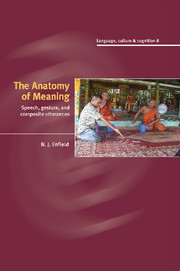3 - Lip-pointing
Published online by Cambridge University Press: 21 July 2009
Summary
Bust a move.
Young MC, 1989Lip-pointing is a widespread form of deictic gesture, a systematic and conventionalized behaviour attested in at least Southeast Asia, the Americas, Africa, Oceania, and Australia. ‘Lip-pointing’ is not an ideal label, since there is more involved in these gestures than merely pointing with the lips. A salient aspect of the gesture is the action of making one or both lips protrude as if using one's lips to point to or at a referent. But there is almost always an accompanying quick raising of the head and chin, and orientation of eye gaze towards the referent, with an occasional eyebrow-raise in addition. The lip-pointing itself is part of a set of deictic actions involving the head and face, and is to be regarded as part of the larger deictic system in which it occurs. Within the relatively little existing research on pointing in general (Hewes 1981, Haviland 1993, Kita 2003, inter alia), lip-pointing receives little mention. Apart from Sherzer's (1973) description of the ‘pointed-lip gesture’ of the Kuna people of San Blas in Panama (cf. also Sherzer 1983, 1993), little can be found on the topic, other than in the context of discussion of hand gesture (e.g. Key 1962: 94, Hewes 1981: 265, Poyatos 1983: 114–116, Wilkins 2003: 174–179) or in linguistic descriptions of demonstratives and other deictic forms (e.g. Feldman 1986: 196).
This chapter describes lip-pointing behaviour of Lao speakers, with additional discussion of lip-pointing more generally (with reference to available data from elsewhere).
- Type
- Chapter
- Information
- The Anatomy of MeaningSpeech, Gesture, and Composite Utterances, pp. 68 - 89Publisher: Cambridge University PressPrint publication year: 2009

